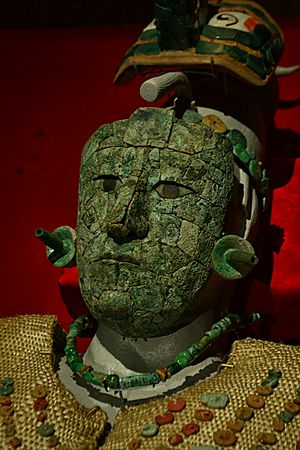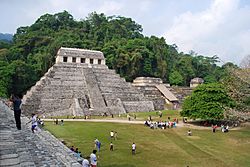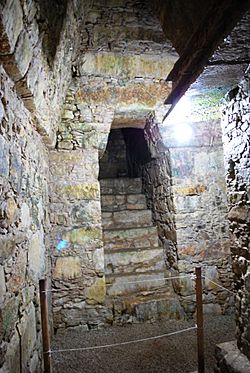Tomb of the Red Queen facts for kids
The Tomb of the Red Queen is a special burial place. It holds the remains of an important noblewoman, possibly Lady Ix Tz'akbu Ajaw. Two servants were also found with her. This tomb is inside Temple XIII in the ancient Maya city of Palenque. Palenque is now a national park in Chiapas, southern Mexico. The tomb is from around 600 to 700 AD. Mexican archaeologist Fanny Lopez Jimenez found it in 1994. She was doing work on the temple stairs. The tomb got its name because the noblewoman's remains and the items in her stone coffin were covered in bright red cinnabar powder.
Contents
Palenque: An Ancient Maya City
Palenque was a very rich and powerful Maya city. It was in Mexico before Europeans arrived. The city was built in the mountains of Chiapas. Many rivers met there, with waterfalls and pools. Its Maya name was Lakam Ha, meaning "big water." People first lived there around 200 AD. The city slowly declined and was abandoned around 800 AD. The jungle then grew over it.
Spanish explorers first saw the ruins in the late 1700s. They even sent soldiers to search for treasure. But they did not find any royal tombs. Later, in the 1800s, other explorers visited. They drew pictures and wrote about the ruins. In 1948, archaeologist Alberto Ruz Lhuillier found a hidden entrance. It led to the Pyramid of the Inscriptions. Four years later, he opened the tomb of Pakal. This tomb held many treasures. But Temple XIII stayed unexplored for many years.
The ruins of Palenque cover a large area. There are hundreds of buildings. In the city center, there is a big palace. There are also three pyramids on the main square. The largest pyramid is the Pyramid of the Inscriptions. It was built for Pakal the Great. He ruled from 615 AD to 683 AD. This was when Palenque was most powerful. A secret stairway inside the pyramid led to his burial room. Next to it are two smaller pyramids. Temple XIII is one of these. It is about twelve meters tall. It has steps and an outside staircase. An inside stairway went into the pyramid's center. But it had fallen apart and was blocked. In 1973, an archaeologist explored the first two levels of Temple XIII. But he did not find the burial chamber entrance.
How the Tomb Was Found
In the spring of 1994, a young Mexican archaeologist was working. Her name was Fanny López Jiménez. She was making repairs on a temple next to the Temple of the Inscriptions. Fanny noticed a small crack on the stairs. It was partly covered by stones and plants. She used a flashlight and a mirror to look inside. She saw a narrow passage. It seemed to lead to a sealed door. She quickly told her team leader, Arnoldo Gonzales Cruz.
The next day, the archaeology team started exploring. They worked for the National Institute of Anthropology and History of Mexico. They found a small blocked door. It was on the second level of the pyramid. It was about 2.8 meters above the main square. The team removed the stones. They found a narrow corridor, six meters long. It was blocked by dirt. This led to another corridor, fifteen meters long. It was made of big limestone blocks. This corridor was clear of dirt. There were three rooms on its south side. Two rooms were open and empty. They showed signs of old rituals. But the third room was blocked by a stone wall. It had stucco and traces of color on it.
The team was very curious about what was inside. But they did not break down the wall right away. They worried about damaging any decorations. After thinking, they made a small hole. It was fifteen by fifteen centimeters. They looked inside. They saw a stone coffin, called a sarcophagus. It looked like a perfectly untouched tomb.
Inside the Burial Chamber
The burial room was 3.8 meters long and 2.5 meters wide. It had a curved stone ceiling. There were no pictures or paintings on the walls. In the middle was a large limestone sarcophagus. It was 2.4 meters long and 1.8 meters wide. It took up almost the whole room. A stone lid, ten centimeters thick, covered it. On top of the lid was a container for burning incense. There was also a small tool for spinning thread.
At one end of the sarcophagus, a skeleton was found. It was a male, about eleven years old. His bones were not well preserved. He was likely a servant. He was sacrificed to go with the Red Queen on her final journey.
At the other end of the sarcophagus was a second skeleton. This was a woman, 30–35 years old. She also seemed to have been sacrificed.
On the first step leading into the room, there were some items. These included a large brown ceramic plate. There were also two orange ceramic vases. Some human bones were found too. These were long bones and teeth with jade in them.
The Sarcophagus and Its Treasures
The archaeologists carefully lifted the sarcophagus lid. They raised it by twenty centimeters. This was very hard work and took fourteen hours. Inside, they found the remains of a woman lying on her back. Her skeleton was covered with many valuable objects. These included jade and pearl items. There were also bone needles and shells. These were once parts of necklaces, earrings, and bracelets. Around her head was a crown made of flat, round jade beads. Pieces of green stone, called malachite, were also there. These were from what had been a funeral mask. On her chest were more flat jade beads. There were also four sharp obsidian blades. A tiny limestone figure was found inside a seashell.
The skeleton, all the objects, and the inside of the sarcophagus were covered. They had a bright red dust on them. This dust was made from cinnabar. Cinnabar is a red mineral that contains mercury.
Who Was the Red Queen?
The "Red Queen's" remains and the items from her tomb were taken for study. They went to a lab in Mexico. Scientists compared the pottery in her tomb to pottery from other Maya sites. This helped them figure out the tomb was from 600-700 AD. They also did carbon-14 tests. These tests help find the age of ancient objects. They also did facial reconstruction studies. They successfully got a DNA sample from her backbone.
Scientists learned she was about sixty years old when she died. She had a serious bone disease called osteoporosis. This made her bones stiff. They also found she ate a lot of meat. Her teeth were very healthy for her age and time. There are no writings in the tomb or other texts. So, her exact identity is not known for sure.
It was clear she was a very important person. Her burial pyramid was next to Pakal the Great's. The items in her tomb were also like those in Pakal's tomb. These included the funeral mask, crown, and other objects. When the tomb was found, some thought she was Pakal's mother. His mother was an important co-ruler for a time. But DNA tests showed the Red Queen was not related to Pakal.
The current idea is that she was Ix Tz'akbu Ajaw. She was Pakal's wife. She was also the grandmother of the last Maya ruler. Arnoldo Gonzalez Cruz and his team hope to find the tombs of Pakal's sons. They might be in other unexplored temples in Palenque. If their DNA is good, it could help confirm her identity. The Red Queen's remains were returned to Palenque in June 2012. They were buried in a different place. The air inside the pyramid was too humid to put her back in the sarcophagus. So, the mystery of who she was continues!
See also
In Spanish: Reina Roja (Palenque) para niños




